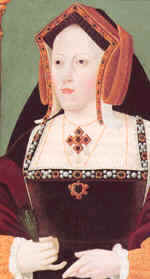Catherine of Aragon was born in 1485 and died in 1536. Catherine was born in Aragon, Spain and her parents were King Ferdinand of Aragon and Queen Isabella of Castille. She was Henry VIII’s first wife and was divorced so that Henry could marry Anne Boleyn.
|
|
Spain and England had a history of poor diplomatic relations and it was common in the Fifteenth Century (and others) for members of a royal family to marry off a daughter or son to a child from another royal family to establish better relations between those two countries. These were diplomatic marriages and the thoughts of the people concerned were not taken into account. In this example, Henry VII wanted better relations with the two major parts of Spain (Castille and Aragon) and Catherine’s parents wanted the same.
Catherine married Arthur, the Prince of Wales and Henry’s older brother, in 1501. When Arthur unexpectedly died in 1502, she married the then Prince Henry as Henry VII was determined to maintain the better relations enjoyed with Spain since Arthur and Catherine’s marriage. Such an arrangement would not have been considered unusual.
Henry succeeded his father in 1509 and the marriage between Catherine and Henry was solemnised at Greenwich two months after Henry was crowned king of England.
Catherine was a highly intelligent person and deeply religious. England was yet to be split by what was to be called the Reformation – the whole country was Roman Catholic. Her lifestyle made her popular with the people who had an historic enmity with any foreigner at this time. Her ‘Spanishness’ was seemingly forgotten about as she adapted to an English royal’s lifestyle.
However, their marriage produced no male heir to the throne. This greatly angered Henry VIII. The marriage did produce the future Mary Tudor.
By 1525, Catherine and Henry no longer lived together as a normal married couple would. Henry became convinced that the marriage was cursed as he had married his brother’s widow. He had also met Anne Boleyn.
Henry wanted to end his marriage to Catherine. However, there was a problem for him. The Roman Catholic Church did not recognise or accept divorce. Henry, as with everybody else in England, was a Roman Catholic. He expected the Roman Catholic Church to make an exception for him as he was king of England. However, the Roman Catholic Church refused to do so.
Between 1527 and 1530, Henry did all that he could to end his marriage to Catherine. All his attempts failed. Throughout these difficult two years, Catherine maintained a dignity about herself and the situation she was in that further endeared her to the people.
In 1530 Henry decided on a different course of action. He decided that he was absolute ruler in all areas in his kingdom – and that included religion and answering religious questions. This was the start of the process that lead to the break from Rome and the Roman Catholic Church and ultimately led to the creation of the Church of England.
The divorce case came before a court in May 10th 1533. It was held in Dunstable and was lead by Archbishop Cranmer – recently appointed Archbishop of Canterbury by Henry. Catherine refused to attend. The case ran its course and the marriage was declared null and void on May 23rd 1533 which gave Henry the divorce he needed. The Roman Catholic Church in Rome refused to recognise the legality of the divorce – not that this affected Henry who had already married Anne Boleyn.
After the divorce, Catherine had to endure not being allowed to see her daughter Mary. She also had to live in less comfortable circumstances than she would have been used to as queen of England.
Catherine died in 1536 probably of cancer. When Henry heard of her death, he celebrated at a banquet dressed in bright yellow from head to toes.
The divorce and its legality was to have an interesting postscript. In 1558, Mary Tudor died. She had been the legitimate heir to the throne. Henry married Anne Boleyn in January 1533 – four months before his divorce was announced. Therefore, he had committed bigamy. This meant, according to those who supported the theory, that Anne’s baby was illegitimate and had no right to the throne when Mary died in 1558. Roman Catholics believed that the rightful heir to the English throne and the person nearest in blood to Mary was Mary, Queen of Scots. The French, for example, considered Mary the rightful ruler of England in 1558 and not Elizabeth, the daughter from the marriage of Anne and Henry.
Related Posts
- Catherine of Aragon was born in 1485 and died in 1536. Catherine was born in Aragon, Spain and her parents were King Ferdinand of Aragon…
- The English Reformation started in the reign of Henry VIII. The English Reformation was to have far reaching consequences in Tudor England. Henry VIII decided…
